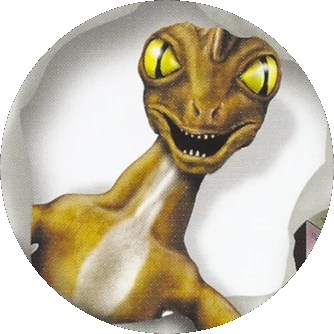The puss moth leads two radically different lives: As a rugged young caterpillar, this grub feeds on plants and defends itself by threatening an attacker and even firing a shot of acid from its mouth. The adult is a beautiful moth covered in soft, thick white hair, somewhat like a Persian cat. It's this hair that gives the "puss" (as in "pussy cat") moth its name.
Chompers: The young puss moth larva has strong jaws that it uses to chomp through tough leaves. Tiny antennae that the caterpillar uses to feel for edible leaves sprout from the sides of the mouth.
Lots a Legs: As a caterpillar, the puss moth has six legs up front and eight legs in back. The front legs are clawed and are used for gripping leaves, while the rear legs are used for walking. Only the front six legs remain in the adult form.
Tough Caterpillar[]

A puss moth caterpillar can't fly away from attackers, so it has other defenses. If an enemy comes near, the caterpillar rears its colorful head. Dark circles on its face look like large eyes (pictured below) and make the insect seem dangerous. Plus, the forked rear has extendable red "tails" that it waves wildly. If a predator persists, the caterpillar can spray a stream of acid from its throat to burn the enemy's skin.
Fooled You! A dark spot appears on the top of a puss moth's egg shortly after it is laid. This spot looks like a hole, and tricks hungry birds into thinking the larva has already hatched.
Bad Eggs: One of the young puss moth's worst enemies is the ichneumon fly. The female of this species has a sting that pierces the caterpillar's skin and injects the fly's eggs. When the eggs hatch, the young eat away at the caterpillar's insides.
The Metamorphosis[]
- The primarily green body of the puss moth caterpillar keeps the animal well camouflaged among leaves. The black "saddle" helps break up the outline of its body.
- When it's time to make the move to adulthood, the caterpillar seeks a secure branch and builds its cocoon, which is brown and also stays hidden from predators.
- Within the cocoon, the caterpillar goes through a complete transformation. It emerges after a few weeks, and is mature, hairy, winged and ready to fly off and find a meal.
Trading Card[]
Trivia[]
- The puss moth is one of three moths whose knowledge card illustration is of their larval stage, along with the Lobster Moth and Hickory Horned Devil.
